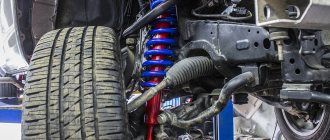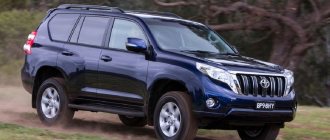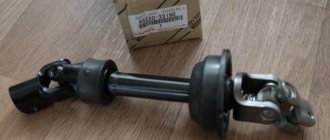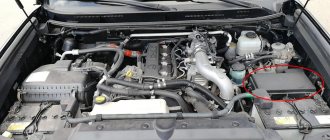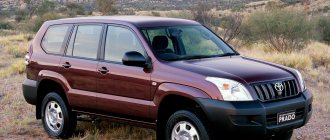Prado 120, 2007 Restyle R2 Operation for about half a year, about 10 thousand km covered.
Differences between the restyle since 08.2007 and previous modifications: 1) Headlights with a graphite tint 2) Casting in graphite color (but can also be found with the previous regular color) 3) The radiator grille is also graphite color 4) A multifunction steering wheel has appeared (buttons only on the left) - radio control 5) The interior has black inserts with natural veneer, not wood! 6) Added body colors: wet asphalt body code: 1E9 and gold: 4R4 7) In the maximum configuration, the spare wheel is only under the bottom
Technical characteristics of Prado 120
: Engine: 1GR-FE, V6 VVTi 4 liters, power: 249 hp, Torque: 382 Nm/3800 rpm. Dynamics: according to the passport: 0-100 km/h: 9.5 sec, max. speed: 175 km/h in fact: 0-100 km/h: 8.5 sec, max. speed 195 km/h Chassis: Front: Double wishbone spring (pass. without TEMS) - upper and lower ball joints, two silent blocks (can be replaced separately with the original if the lever is normal) Rear: Four-link spring (passenger without TEMS) Tires: 265x65xR17 + Same spare wheel
Body: on frame Brakes:
ventilated discs (like all Toyotas there is beating - treatment is by turning the discs (up to three times) with replacing the pads (ideal) or replacing the discs. In addition to the brakes: ABS + EBD (brake force distribution) + BA (emergency brake booster - WORKS !)
Systems:
VSC (vehicle stability) - can be turned off by turning on: APK:N then transfer case L button center differential and automatic transmission: DL, A-TRC (active traction control) - cannot be turned off completely, - transfer case to help! DAC (descent assist system from the mountain) - it is turned on by the previously switched on automatic transmission: N on the transfer case L, automatic transmission: L and the DAC button. Well, on a steep slope it works - everything crackles))
Minimum ground clearance: 220mm Approach angle: 32 degrees Departure angle: 27 degrees Fording depth: 700mm Roll angle: 42 degrees (Hammer H1 52 degrees)))
Dimensions: LxWxH (mm): 4850x1875x1895 curb weight (kg): 1900-2070 Gross weight: 2850 kg Turning radius: 5.7m
Fuel tank: 87 l Consumption: Highway: from 12 l (usually 14 l), city from 17 l Benz according to the passport 95, in fact 92 is better
Differences in gasoline trim levels: for the Russian Federation and Belarus: Maximum speed: 6 (R2 Sol) airbags versus 2 (R1 Luna) R2 has pneuma and a TEMS shock absorber system (4 modes) - this is really better than conventional shock absorbers, and the pneuma is adjustable up to 7 cm. The R2 has a vinyl (leatherette) interior The R2 has seats with electric drives The R2 has a rear air conditioner - NOT A OVEN The R2 has a headlight washer - a useless thing - there is no such pressure as is needed! R2 has 8 seats (third headrest in the seat)
Cons IMHO:
1) Handling - very rolly in corners, TEMS does not help, although it is a little better than regular shock absorbers. In turns, slow down the speed - otherwise you'll be lucky, but it's better to reduce the speed - otherwise a rollover is easy (this also applies to the LC200 and LC150). 2) Vinyl interior (leatherette) near the driver’s seat (leatherette) can crack even in half a year! 3) The paintwork is thin AT ALL! 4) radio tape recorder - with cassette support! why do we need MP3?! But I’m silent about the camera 5) The second row of seats is not longitudinally adjustable! 6) The third row is generally nonsense - for an adult 170 cm tall, resting his knees on the second row is somehow bad! And 3 more seats - if you only seat the children. 7) The spare wheel under the BOTTOM is probably not a minus - it’s just that the wheel is so heavy and bulky (about 22 kg). The 4L petrol does not have a rear differential lock - although it can be installed separately, but cars from Europe have diesel engines. 9) In Ukrainian. in the maximum speed there is a sunroof and a refrigerator, but the Russian Federation does not (( 10) heated seats are terrible, after 5 years of operation sometimes you have to change the heaters - the original is gone! EmelyaUK 11 is suitable) there are no parking sensors in the database - this was designed for the Russian creative soul - here and they supply all the colors of the rainbow and different tea brands.
In turns, slow down the speed - otherwise you'll be lucky, but it's better to reduce the speed - otherwise a rollover is easy (this also applies to the LC200 and LC150). 2) Vinyl interior (leatherette) near the driver’s seat (leatherette) can crack even in half a year! 3) The paintwork is thin AT ALL! 4) radio tape recorder - with cassette support! why do we need MP3?! But I’m silent about the camera 5) The second row of seats is not longitudinally adjustable! 6) The third row is generally nonsense - for an adult 170 cm tall, resting his knees on the second row is somehow bad! And 3 more seats - if you only seat the children. 7) The spare wheel under the BOTTOM is probably not a minus - it’s just that the wheel is so heavy and bulky (about 22 kg). The 4L petrol does not have a rear differential lock - although it can be installed separately, but cars from Europe have diesel engines. 9) In Ukrainian. in the maximum speed there is a sunroof and a refrigerator, but the Russian Federation does not (( 10) heated seats are terrible, after 5 years of operation sometimes you have to change the heaters - the original is gone! EmelyaUK 11 is suitable) there are no parking sensors in the database - this was designed for the Russian creative soul - here and they supply all the colors of the rainbow and different tea brands.
Toyota Land Cruiser Prado 120 is a combination of off-road capability, comfort and reliability. He also knows how to charm his owners - 8 out of 10 are happy with everything and are not ready to part with him. In the article we will figure out how smooth everything is. Is it worth getting involved with a large frame SUV with mileage? If you decide, then read below what to look for when buying a used Prado 120.
A little history
The Prado model was born in 1985 in the form of the 70th series. They have little in common with the 120 (in fact, only the name). In 1996, the Land Cruiser Prado was reborn into the 90th series. Like the 120, it is created on the Toyota 4Runner platform and with independent front suspension. It was positioned as the main competitor to the Mitsubishi Pajero. But there were no sales records, perhaps due to low-power engines.
The third generation of the Japanese SUV turned out to be a real breakthrough for Toyota. The LC Prado 120 is still liked by many both in appearance and in its characteristics. Although technically he is not without sin. More details below.
The 120th series was produced from 2002 to 2009. There was only one official restyling during this time, in 2007. The changes are purely cosmetic: the headlights and chrome on the radiator grille were darkened, buttons were added to the steering wheel and black wood-look inserts were added to the interior. And in 2008, the surrounds of the audio speakers in the doors were made silver.
More significant changes took place in August 2004. Then the 4-speed automatic was replaced with a 5-speed one and the 2.7-liter engine was updated.
Owner reviews
SUV owners leave mostly positive reviews. Many note its reliability, spaciousness, and comfort. The downside is high fuel consumption.
Vadim, Moscow:
“A real pleasure to drive. Snow and off-road conditions are not a test. The car is reliable, you feel confident. I did the modification myself, and bought the restyling kit from the “officials.”
Irina, Vladivostok:
“I took my Pradik from the salon. I only use it around the city. Before this crossover, I owned several different cars, but this is the only one I feel so confident in.”
Alexey, St. Petersburg:
“I bought it for family trips. When choosing a model, the main conditions were comfort, safety and spaciousness. Expectations were fully justified.”
Body
The frame of the TLC Prado 120 is associated with something unshakable and eternal, but this is not always the case. Its first enemy is corrosion. This is especially true for vehicles in the possession of “true SUVs”. Dirt and water get inside the frame and make the corrosion process almost irreversible.
With urban use and anti-corrosion treatment, there may not be a problem with a rusty frame. It is necessary to check, since there is a number stamped on the frame (sometimes you come across unnumbered ones). If the number is damaged or there are traces of non-factory welding, registration will not be possible.
The body itself corrodes reluctantly and also largely depends on use. The more dirt the Prado sees, the more rust it has. Check the first outbreaks on the rear door and under the plastic lining of the arches and doors. If there are severe chips on the hood, the paint may “swell.”
Toyota Prado plates with the Vin number are very easy to change. They are on rivets. Do not waste money and time on a legal check of the car before purchasing. The love for the Prado in criminal circles and the popularity of the model significantly increase the likelihood of encountering a “dubious specimen.” The number of the body, frame and documents of the car should not raise any doubts.
The Prado 120, unlike the Land Cruiser 100, also has a 3-door body modification ( RZ ). It is very rare - 5 out of 500 cars on sale. And it differs only in size.
Do not make hasty conclusions if the windshield of the Land Cruiser Prado 120 is not original. Toyota made it a little fragile. It wears out quickly and breaks easily due to oncoming stones.
Differences between Arabic and European versions
Globally, the Toyota Land Cruiser Prado 120 is no different for different markets. The same body, the same chassis, the same engines (except for the domestic Japanese market). The difference lies in the details and configurations. There is an opinion that the “Arabs” have worse anti-corrosion treatment of the body, but there are no specific tests or evidence.
The main features of the Arabic modification:
- Arabic script anywhere in the car - on plates, mirrors. This is the first and sure sign of eastern origin.
- Front bumper trim and chrome mirrors. These elements may also be tuning, so they cannot serve as a sure sign.
- The Arabs do not have heated side mirrors.
- No headlight washers. There are not even plugs on the bumper.
- The configuration with two fuel tanks and a refrigerator in the armrest is only possible with the “Arab” Prado 120.
- The thermostat turns on at 82 degrees , in Europe - at 88 (during operation in our area, it has almost certainly already been changed).
- On the rear door there is the inscription Land Cruiser PRADO on the left , and VX or GX on the right (see above for decoding).
If you have anything to add to this list, write in the comments.
Engines Prado 120
The choice of motors is small, but they are all very reliable. There are a couple of questions about diesel engines. Almost all of them relate to our poor fuel and “so-so” service. More details below.
Gasoline
2.7 liters (3RZ-FE, 2TR-FE). The motor is reliable, and one of the most controversial in terms of choice. Discussions on the topic of going/not going, eating/not eating still exist. This engine was not officially supplied to Europe.
Until 2004, the Prado 120 was equipped with a modification of the 3RZ-FE engine (150 hp). This is the one that receives the most complaints about “doesn’t work.” After 2004, they began to install a modified version of the 2TR-FE engine (163 hp) with VVT-i (variable valve timing). They also added a new plastic intake manifold and an electronic gas pedal (throttle). As a result:
- + 13 horsepower;
- Better traction at the bottom;
- Gasoline consumption is 1.5-2 liters/100 km less.
Of course, compared to its older four-liter brother, this is a small breakthrough. But for leisurely movement around the city it is enough. In this case, the consumption will be around 15 liters per hundred kilometers.
Carrying two tons of weight is not easy. Therefore, the load on the four-cylinder engine is large. Trouble-free operation resource is 250-300 thousand km. Under difficult operating conditions, it may be necessary to change the stretched timing chain after 150 thousand km. The front crankshaft oil seal may leak, but this is not a global problem.
3.4 liters (5VZ-FE, 178 hp). Already 6 cylinders. The engine was produced only for the Japanese domestic market. It is a rare unit in our area, so there are practically no statistics on operation.
4.0 liters (1GR-FE, 249 hp). Six-cylinder engine with power reserve. Allows you to accelerate the heavy TLK Prado 120 to hundreds in almost 9 seconds. The engine life with normal maintenance is more than 400 thousand km. Appetite in the city is 16+ liters (depending on driving style).
There are no hydraulic compensators in the engine, therefore, according to the regulations, the valve is supposed to be adjusted manually every 100 thousand km. In practice, valve clearance changes very slowly. In reality, adjustment may be needed after 250 thousand km, and not always. The chain drive easily runs up to 300 thousand km. Current crankshaft seals (both front and rear) may be disturbed.
If the engine is unstable and you are concerned about increased gasoline consumption, you will need to flush the fuel injectors. With our gasoline, it is better to do this procedure every 60-100 thousand km, for prevention. If this does not help, then you will have to rinse the tank (you need to remove it completely) and the submersible filter of the fuel pump.
Diesel
Diesel Prado 120 is no more than 20% of the total number on sale. Therefore, finding a decent copy will be more difficult. In addition, diesel units in our conditions behave more capriciously than gasoline ones. Buying a diesel engine should be conscious. You should not hope that you will save money at gas stations, since the probability of repairing fuel equipment is 50/50.
The engines themselves are reliable. They are ruined by poor service and low-quality diesel fuel. Officially, only the three-liter 1KD-FTV . The Common Rail fuel system is very sensitive to the quality of diesel fuel. If you can’t refuel with high-quality diesel fuel, then don’t even consider this option. Additional fuel filters are a plus for engine life. Until 2004, 1KD-FTV developed 163 hp. s., after - 173 l. With.
The Arabian 120th Prado can be equipped with a 3-liter turbodiesel 1KZ-TE (131 hp) or naturally aspirated 5L-E (95 hp). The first one has a mechanical injection pump and is not so picky about the quality of diesel fuel. This motor is known to the masters, since it “came” back from the 90th Prado. The second is frankly weak, but without “extra” expensive parts such as a turbine. The resource of the latter, by the way, for “Prad” diesel engines is about 200 thousand km.
The timing drive in diesel engines is belt driven. This means that you will have to change it every 150 thousand km. The consequences of a broken belt are expensive to eliminate. It is also necessary to monitor the condition of the fuel injector gaskets. If at least one burns out, the engine will begin to “suck” air. Because of this, carbon deposits form in the oil intake. When a critical mass of deposits accumulates, oil starvation begins and the rapid “death” of the engine begins.
As a result, the “European diesel” is more powerful, but more capricious. “Arabian” is almost omnivorous, but in a neglected state it will also ask for money. Therefore, we repeat: choose a diesel Prado consciously, only if you know how to choose and maintain it correctly.
Transmission
The gearboxes of the Toyota Land Cruiser Prado 120 are also designed with a safety margin. Mechanical is rare (21 out of 659 on sale). Until August 2004, the automatic transmission was four-speed (A340), after - five (A750). This did not affect reliability. 200-300 thousand mileage without repair is quite a standard indicator.
The service life is greatly reduced by off-road “forays”, aggressive “rolling” in the snow and constant towing of heavy loads. Therefore, before buying a Toyota Prado 120, be sure to pay attention to any shocks during shifts and the smell of burning on the automatic transmission oil dipstick - this should not happen. However, the dipstick is only available on the 4-speed gearbox. Changing the oil in automatic transmissions is not regulated by the manufacturer. But for long and trouble-free operation of the box, it is better to change the oil every 60 thousand km.
All-wheel drive doesn't cause much trouble. The safety margin of the gearboxes is 250+ thousand km. You need to keep the breather clean. If it is clogged, then due to pressure the oil is squeezed out through the seals. And if the level of lubrication is insufficient, increased wear occurs. In other words, a clogged breather can quickly “kill” the gearbox.
Some 120s come with a differential lock. But it is intended for use in extreme situations (if it is firmly seated) and at minimum speeds (up to 8 km/h). It's like firefighters - only break glass in case of fire.
Interior and equipment
The ergonomics of the driver's seat have been improved: in the center of the dashboard there is a multifunctional color display with a 4.2-inch diagonal. Comfort control switches, transmission options and advanced driver assistance systems are grouped in the central part of the console panel.
For the first time, this model is equipped with Toyota Safety Sense - a system that combines four safety technologies:
- automatic high beam control - ensures safety while driving at night;
- recognition and information about road signs;
- Lane Departure Alert—detects visible lane lines using a camera mounted on the top of the windshield;
- Forward Collision Warning (includes adaptive cruise control with automatic slowing functions)—Informs you of objects moving ahead to help avoid frontal collisions or collisions with pedestrians and cyclists.
The design and functionality of the steering system has been unified for the Land Cruiser 200, and the automatic transmission controls have been updated.
New interior materials harmonize with the ambient lighting, creating an atmosphere of luxury and impeccable style. Model covers, practical floor mats and trunk mats complete the feeling of comfort.
Brakes and steering
The braking system is not as thoroughly reliable as other components. Often due to irregular service. To keep your brakes working like a charm, you need to regularly clean and lubricate the caliper and pad guides. It is advisable to do this with every pad replacement. Changing the brake fluid every year or two (depending on mileage) will also prolong trouble-free braking.
If the brake pedal fails or becomes weak, many “service men” are immediately ordered to replace the brake pedal (brake master cylinder). The part is not cheap, and it is not always necessary to change it. It’s better to start with the reservoir cap, hydraulic accumulator and GTZ piston. The latter was supplied separately until 2004, and after that it fits from the 150th Prado (more details on the specialized forum).
Check the handbrake before purchasing. Replacing soured cables with labor will cost $100.
The safety margin of the steering rods is huge. But the splines of the steering column and the crosspiece of the steering cardan can be disturbed before 200 thousand mileage. If the steering wheel “gives” on bumps, then it’s time to change the elastic coupling. At “famous” services, the problem with the steering column is solved by replacing it as an assembly. At a service station, in a simpler way and with a “creative approach,” you can solve the problem several times cheaper.
Taxiing is not the 120th Prado's strong point. There is even a myth about its super-propensity to capsize. There is some truth to this due to the high suspension. But with adequate driving and a working suspension, it will be difficult to overturn the Prado.
Multimedia
The multimedia complex is not the newest, but it looks decent. The screen is large, all images are clearly visible from it. According to reviews from owners, it is sometimes difficult to reach for it.
The Prado is equipped with a high-quality audio system with six speakers. A car radio with nine speakers is available for an additional cost. The expensive equipment is equipped with a JBL audio system, 14 speakers, and multimedia with an LED display.
Navigation is set in Russian. Connection via Bluetooth is available, there are AUX, USB connectors. Owners note the high sound quality.




